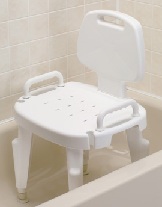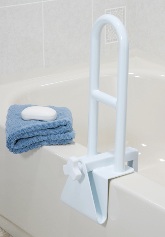Blog Roll: (Contributors)
» Hulet Smith, OT
» Megan Smith, PT
» Mike Price, OT
Topics:
Adaptive Devices
Adult Tricycles
Air Purifier
Allergy
Alternative Communication Devices
Alzheimer's Dementia Products
Aquatic Products
Arthritis Relief Products
Autism
Back Relief
Ball Pit/Pool
Bariatric
Bath Benches
Bathtub Lift
Bed Rails
Bedsores / Decubitus
Bidet
Body Solid Exercise Products
Breast Feeding Products
Bushel Trucks
Cancer
Catheters
CEU
Changing Bench
Child Car Seats
Child Care Products
Christmas Gifts
Clinic/Medical Equipment
Clinical Furniture
Cold and Flu
Communication Devices
Compression Garments
Computer Products
CPAP
Crutches
Daily Assistance Products
Daylight Lamps
Dental Care
Diabetes
Doctor's Office
Dysphagia
Electrodes
Electrolarynx
Emergency Preparedness
Ergonomic Equipment
Exam Tables
Exercise Products
Eyecare
Family Tricycles
First Aid Kits
Floor Scales
Fluidotherapy
Foot Drop
Foul Weather Gear
Furniture
Gait Trainers
General Articles
General Posts
Glassless Mirrors
Hand Sanitizer
Head Protection Helmets
Hearing Impaired
Heart Health
Heating Pad
Hip Fractures
Home Assistance Products
Home/Office Assistance
Hospital Beds
Hoyer Lifts
Hyperbaric chamber
Hyperthermia/Hypothermia
Ice/Hydration Carts
Impotence Products
Incontinence Products
Infection Control Gowns
Inspirational Stories
Lift Chairs
Light Therapy
Low Vision Products
Massage Tables & Chairs
Massage Units
Maternity
Medical Facility Products
Medical Scales
Multi-Sensory Environment
Natural Healing
Nebulizers
Non-Hospital Bedding
Nutritional Supplements
Office Furniture
One-Handed Products
Operating Room Devices
Ostomy Products
Oxygen Compressors
Oxygen Concentrator
Oxygen/Nebulizer Masks
Pain Relief
Paraffin Unit
Patient Lift
Patient Lifts
Patient Restraints
Patient Transfer Systems
Pediatric Bath Chairs
Pediatric Furniture
Pediatric Learning
Pediatric Recreation
Personal Listening Devices
Personal Warming Products
Physical Therapy
Pill Organizers
Pillows
Playground Equipment
Pool Lifts
Press Releases
Procedure Chairs
Pulse Oximeter
Reading Assistance
Reference Materials
Rehab Equipment
Rehabmart News
Rehabmart Newsletter
Respiratory Health
Rollators
Saunas
Scooters
Seniors
Shower Chairs
Shower Commode Chairs
Shower Gurney
Showers Chairs
Side Access Bathtubs
Skin Tear
Special Needs Dinnerware
Special Needs Seating
Special Report Articles
Splints
Sport Injuries
Standers
Staying Home
Stethoscopes
Stimulus Reward Toys
Stress Relief
Stroke
Strollers
Summertime Products and Summertime Fun
Talking Products
Therapy Balls
TheraTogs
Thermometers
Traction Devices & Tables
Treatment Tables
Ultrasound
Vibroacoustic Therapy
Vision Products
Walk-In Bathtub
Walking Aids
Walking Boot
Weighted Wearables
Wheelchair Accessories
Wheelchair Cushions
Wheelchair Lifts
Wheelchair Ramps
Wheelchair Transfer Systems
Wheelchairs
Women's Health
Work Hardening Products
Wound Care
Bathroom Slips and Falls of the Elderly Can Be Prevented
I have to admit something. I enjoy watching the television show "America's Funniest Home Videos" and my favorite clips on the show are people falling down. Usually someone falling at a wedding is the funniest, but I digress. The truth of the matter is that for some people and mostly for the elderly, falling is not funny at all, and could even be life threatening.
For the elderly population, falling is less slapstick comedy and more of a potential major health concern. It has been reported by the CDC that about 33% of people 65 years or older will fall, possibly suffering hip fractures and/or head injuries. Due to the age and body health of the elderly, these moderate to severe falling injuries are the most common cause of hospital admissions and nonfatal injuries. For example, as late as 2012, over two million nonfatal injuries due to falling among older adults were treated in emergency rooms, with over half-a-million being hospitalized. Sometimes, too often, these mostly preventable fall injuries can increase the risk of an early demise.
Besides the fear and trouble of being hospitalized with a fall injury, after the hospital stay these injuries can, in various degrees, decrease a person's daily function and movement and the ability to live independently, and not only physically. Many elderly people who have fallen may develop a fear of falling again. Even the individuals who did not suffer any injury, often times thinking that they were lucky enough to beat the odds of the first fall, can develop some unhealthy stress that the 'next' slip and fall might be the bad one. Being aware of the physical reality of a broken wrist or hip from a slip and fall, elderly individuals may needlessly limit or alter their activities and lifestyle.
And the truth of the matter is that many types of falls by the elderly can be anticipated and therefore can be avoided.
Some ways to avoid more of the severe falling injuries for the elderly is to exercise on a regular schedule. Water exercise and Tai Chi programs are especially good for core-building strength. Reviewing an individual's medications with the doctor who prescribed them can assist in determining if any side effects or interactions such as drowsiness or dizziness could result in a falling accident. Checking an elderly person's eyesight can also help prevent unseen obstacles, and bifocals are often a culprit in misjudging distances.
Another way to avoid possible falling mishaps is to try to reduce the tripping and falling hazards located within an elderly person's home, with a special eye on the bathroom as this is the most dangerous falling hazard room in the home. Bathroom safety should be a major concern for an elderly person or for someone who has an older parent. Some of the ways to make their homes safer from tripping, slipping, and falling in the bathroom is to install grab bars inside and outside the tub or shower and also next to the toilet. Additionally, having a bathtub or shower chair can greatly assist an elderly person from have a nasty fall while bathing.
One example of bathroom safety offered by Rehabmart is the easily assembled Knock Down Bariatric Transfer Bench. "Knock Down" meaning this sturdy yet lightweight corrosion-resistant, 500 pound capacity transfer bench can assemble easily and with no tools. It also comes with a blow-molded reversible plastic backrest that can accommodate any bathroom, and extra-large locking suction cups to provide added safety against slips and falls.


Having grab bars in the bathing area or next to the toilet is another good idea. For many elderly people, getting up from a sitting position in a slippery environment can become a circus-type of performance with the balancing, twisting, and leg-lifting, and having a grab bar to help steady and pull one's self up is a huge relief. The Telescoping Portable Grab Bar an be installed and removed without tools or professional installation. Adaptable to most tub or shower tile configurations and because it will not deface or damage property, this is a great traveling companion to be used in different tubs or showers during vacations, hotel stays, for visiting guests in your own home, or if you rent a house or apartment.

Another type of grab bar to use to help steady and support getting in and out of a bathtub is a bath tub rail. The Clamp On Tub Rail handle design provides a secure hand position for easy grasping while transferring in and out of the tub. This tub rail has a stainless steel locking mechanism and uses non-wearing rubber pads, providing scratch-proof security. This white powder-coated steel constructed tub rail is durable and attractive and its tool free installation will fit most non-fiberglass tubs.
As human beings age into their golden years, more often than not they also become physically weaker and more unsteady on their feet. Being able to inexpensively and easily help calm the fear of falling in the bathroom and even prevent a dangerous slip or fall is a really good idea to plan for in the future. Many of us have parents who are at the age that one simple accident can come with unwanted and severe consequences. Help stave off the possibility of a slip and fall by simply installing bath benches and hand holds.
Benjamin Franklin might not have specifically had bathroom safety in mind when he came up with this famous observation, but he does sum it up best: "An ounce of prevention is worth a pound of cure".
Bill Stock
Executive Editor,
Content & Social Media Services
and
Hulet Smith, OT
Rehabmart Team Leader & CEO
